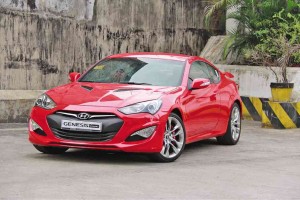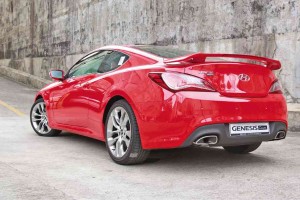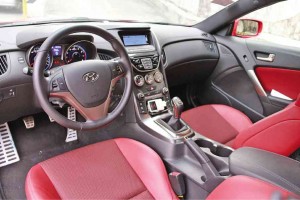Hyundai was ahead of the pack when it introduced the Genesis Coupe at the 2009 Manila International Auto Show. Here was a low-slung rear-wheel-drive coupe with a choice of potent engines, carrying the brand’s new luxury sub-brand, and starting at a very affordable price point. Its success paved the way for the slew of sports cars that have followed: the Toyota 86, Subaru BRZ, Ford Mustang, and Chevrolet Camaro. Those who could see past the Hyundai badge—not traditionally associated with performance machines—discovered a car that carried adequate power (ample with the V6 variant), responsive handling, and an interior that was snug but comfortably capable of carrying four people.
Last year, just in time to make the car more competitive against all the new models, the Genesis Coupe received multiple upgrades. First off is the revised styling, making the car look less geeky and more muscular. The new front end is in the vein of the Accent and Elantra, with beady headlamps and hexagonal center section. The hood features more sculpting with a couple of fake nostrils on top. The rear, Hyundai’s best angle, retains the bulging haunches and the perfectly proportioned sloping backlight that merges with the trunk. New also is the wing-type
rear spoiler, which may not be to everyone’s taste.
Inside, the Coupe gets an improvement in materials and some tweaks in design. The audio unit switches have moved high on the center panel. The air-conditioner switches have moved lower and the system features automatic climate control. Perhaps the best addition is the telescoping feature of the steering wheel, allowing the driver to find a much more comfortable driving position than the previous rake-adjustable only wheel. The dashboard now has better plastics, and features double stitching on many surfaces. The seats are available in a bright red leather-fabric combination that matched the exterior color of our test car. The iPod/USB plugs have moved to the center of the instrument panel. We preferred their former location in the center console box, but then with streaming capabilities the position may be increasing irrelevant. The main gauges now have better backlighting and get digital fuel and temp gauges. A quirky touch are the three circular analog gauges mounted in the middle. The center displays boost pressure and the right gauge shows oil temperature. Amusingly, the left dial displays the amount of acceleration deployed, or rather the amount of pressure on the accelerator pedal, in percentage. It’s amusing for the first five minutes or so, then quickly forgotten. Passengers may get a kick of out them, though.
Feel the difference
If the front passenger were to keep an eye on the accelerator gauge, he may notice that the car responds quite quickly to input from the pedal. The driver will feel the difference immediately from the previous model to the 2013 car. The acceleration of the 2-liter turbo is more linear and with much less turbo lag. Response is instantaneous, with good torque even below 2500 rpm. Power has been kicked up on the four-cylinder to 257 hp, and torque is a brawny 353 Nm. With the more responsive engine, the car is much more pleasant to drive in all traffic situations. As with the pre-facelift model, the engine is mated to a six-speed manual. The gear lever has changed shape, but the shift action remains similar, with a notchy shift feel. The clutch lever is not that stiff, and easy to engage even if you have to slog through traffic. The automatic gets a significant upgrade, with a new 8-speed transmission.
Peeking behind the aggressive new 19-inch alloy wheels are the distinctive red calipers of the Brembo brakes. The brake system is available as a separate variant on the manual versions of both the 2.0 inline-four and the 3.8 V6.
Handling is pleasantly weighted, responsive but not twitchy. It has more of a “heavy cruiser” feel when compared to lightweight, quick-turning cars like the BRZ and 86. This may rob it of the instant fun factor, but then the Genesis Coupe is designed for a slightly different purpose. It’s markedly bigger, to carry two petite rear passengers in comfort, and is heavier to better absorb bumps and road irregularities. Driving in a Genesis Coupe the whole day will not tire out the driver, given its more luxury-oriented driving and handling characteristics.
Right upgrades
With the onset of multiple rivals, both from small and quick sports cars to heavier GTs like itself, the Hyundai Genesis Coupe has received just the right amount of significant upgrades to make itself a strong contender in what has become, in a very pleasant surprise, a crowded segment of performance vehicles.
The 2013 Hyundai Genesis 3.8 hasn’t lost the premium soft ride feel that sort of dictates the car’s grand touring intentions. Paired with good acoustics, the front and even rear seat has ample room for longer trips that will not tire out the passengers and a nice 442 liters of cargo room in the trunk area for long out-of-town trips. With a nice quiet interior cocoon that can compares fairly well with its more premium rivals, the huskier V6 engine also offers a quicker performance but similar “cruiser” feel as its in-line 4-cylinder variant. Its steering also gives good feedback with precision and control to match the more powerful engine, giving it a more robust and dynamic driving experience.
COTY award
In just a few years, as the nameplate implies gives Hyundai a relatively new and exciting product in this highly competitive and performance-oriented segment where other more traditional rear-wheel-drive nameplates have more equity and provenance. It seems with a well-chosen set of variants and spec sheets, the Genesis is holding its own growing number of followers. In the 2013 Manila International Auto Show, the Genesis received the Car of the Year Awards (COTY) as “Best RWD (rear wheel drive) Sports Car” awarded by the Car Awards Group Inc., besting its rivals in the segment. The Genesis was part of a culmination of a year’s testing, preparations and deliberations by the Car Awards Group Inc. (Cagi) where this year saw a field of 81 new cars, crossovers, SUVs, trucks, sports cars and vans that competed in 19 different categories, including the over-all winner getting the most coveted title of Car Of The Year-Philippines.
Cagi is an organization founded in 2004 by a group of the most respected motoring journalists in the country, with the objective of spurring industry growth in the automotive sector by informing the motoring public of product excellence through the Car of the Year Awards. Since then, the organization has grown to encompass over 50 members from the nation’s leading broadcast, print and online media outlets. Testing procedures have also been refined to consider the needs, wants and preferences of the car buying public as well as absolute performance characteristics of each newly introduced vehicle every year.




